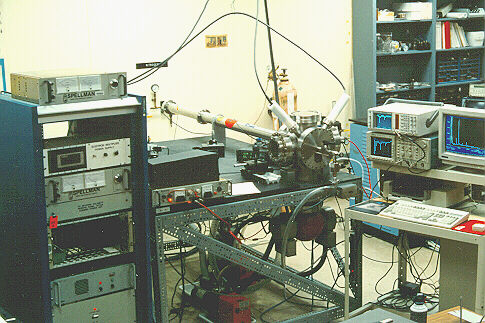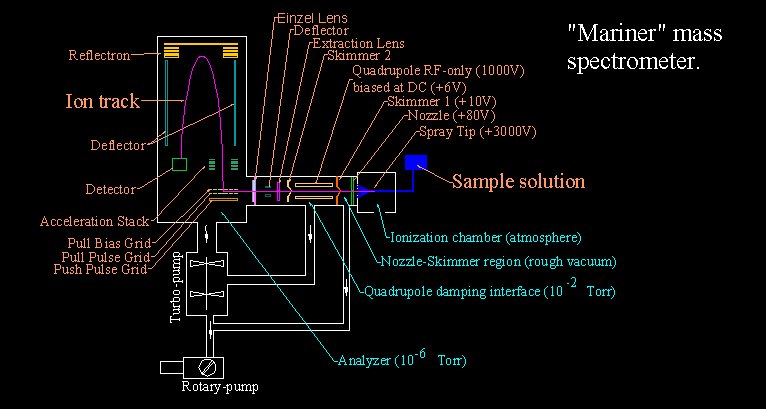
This is a homebuilt linear time-of-flight (TOF) mass spectrometer, equipped with a Continuum Surelite I Nd:YAG laser with the 532, 355, and 266 nm wavelengths available. Laser optics include a 90 degree beam steering prism, a Newport 935 attenuator and a 305 mm focal length quartz lens on an adjustable stage placed approx. 300 mm from the sample surface. Flight tube length is a nominal 2 meters.

The instrument can be quickly configured to observe positive or negative ions. A +/- 30 kV Spellman power supply is used for ion acceleration through a gridded two-stage source. Ion transmission is assisted by an electrostatic particle guide which runs the length of the flight tube.
Ion detection is accomplished with a hybrid micro-channel plate/discrete dynode electron multiplier. Real-time observation of ion signal is done with a Tektronix TDS 310 digital oscilloscope, and a Tektronix TDS 520A is used as a transient recorder. Data is transferred from the TDS 520A to a 486 PC-compatible computer via the GPIB interface. Instrument control and data acquisition are accomplished through a graphical user interface, and data analysis is done with the LabCalc package from Galactic Industries.
A 3-axis (x,y,z) translation stage/ion source can also be fitted to the instrument to accomodate sample platforms that are different in size and/or configuration than the normal sample tips. This source allows samples to be cooled to liquid nitrogen temperature under vacuum and at high voltage..
The Mariner instrument is a versatile orthogonal extraction reflectron time-of-flight mass spectrometer, originally equipped for electrospray ionization (ESI). Mass range is up to 8,000 Da and mass resolving power is typically 4,000. In the default ESI operational mode, samples can be introduced sequentially through a stainless steel capillary driven by a syringe pump or individually from a disposable plastic pipette tip [“Electrospray ionization using disposable plastic pipette tips”, Sergei A. Aksyonov and Peter Williams, Rapid Commun. Mass Spectrom. 15 (2001) 1890-1891].

The Mariner has been modified to explore a new and novel ionization
method, Impact Desolvation of Electrosprayed Microdroplets (IDEM)
[“Impact desolvation of electrosprayed microdroplets – a new ionization
method for mass
spectrometry of large biomolecules”, Sergei. A. Aksyonov and Peter
Williams, Rapid Commun. Mass Spectrom. 15 (2001) 2001-2006].
In this approach, biomolecular analytes, specifically DNA, are dissolved
in 1-2 M ammonium acetate which is electrosprayed in vacuum to produce
highly-charged microdroplets. These droplets, carrying hundreds or
even thousands of proton charges are accelerated through a potential drop
~ 5 kV to final energies in the range of MeV to perhaps hundreds of MeV,
depending on the droplet charge and allowed to strike a metal target surface.
Because the final velocity of the droplets can be several thousand
m/s, this impact causes rapid shock heating and explosion of the droplets,
producing free, unsolvated analyte ions. Mass spectra of mixed-base
DNA oligomers up to the 12-mer exhibit minimal fragmentation, a low degree
of multiple charging (only singly and doubly-charged ions are detected)
and minimal peak broadening due to solvent and salt adducts, making the
technique promising for rapid analysis of DNA sequence ladder mixtures.
![[ <- ]](docsleft.gif) Back to Lab Page
Back to Lab Page